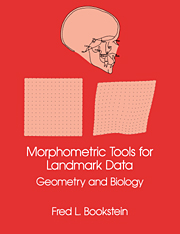2 - Preliminaries
Published online by Cambridge University Press: 23 November 2009
Summary
This chapter assembles miscellaneous topics that underlie the statistical, geometrical, and biological reasoning about morphometric data and morphometric explanations put forward in this volume. Section 2.1 deals with the progression of insights by which the synthesis reported here emerged in the 1980s out of a creative but disorganized earlier literature spanning most of the century. Two dogmas–that one should analyze landmark coordinates without specifying particular size or shape measures in advance, and that such analyses should be no less symmetric than the Euclidean plane or space of the data – underlie the development and dissemination of Principles 1–4 of Chapter 1. The core of this chapter, Sections 2.2 and 2.3, is a review of two very useful techniques I have borrowed from other disciplines for applications in morphometrics. The thin-plate spline is an interpolation function originally developed for computational surface theory and computer graphics; here I am suggesting it as the most appropriate formalism currently available for D'Arcy Thompson's old theme of biological homology as a geometric mapping. By the end of Chapter 7 the reader may be convinced that in its algebra and its geometry these interpolants have exactly the right flexibility for the interplay with biological explanations at many different physical scales. In particular, the nonnegative-definite quadratic form of deficient rank that was referred to in the preceding chapter as “bending energy,” which drives the regional analysis of shape change, is copied verbatim from the spline literature. The second major borrowing is from Sewall Wright's model for biometrical explanation as path analysis.
- Type
- Chapter
- Information
- Morphometric Tools for Landmark DataGeometry and Biology, pp. 20 - 54Publisher: Cambridge University PressPrint publication year: 1992



